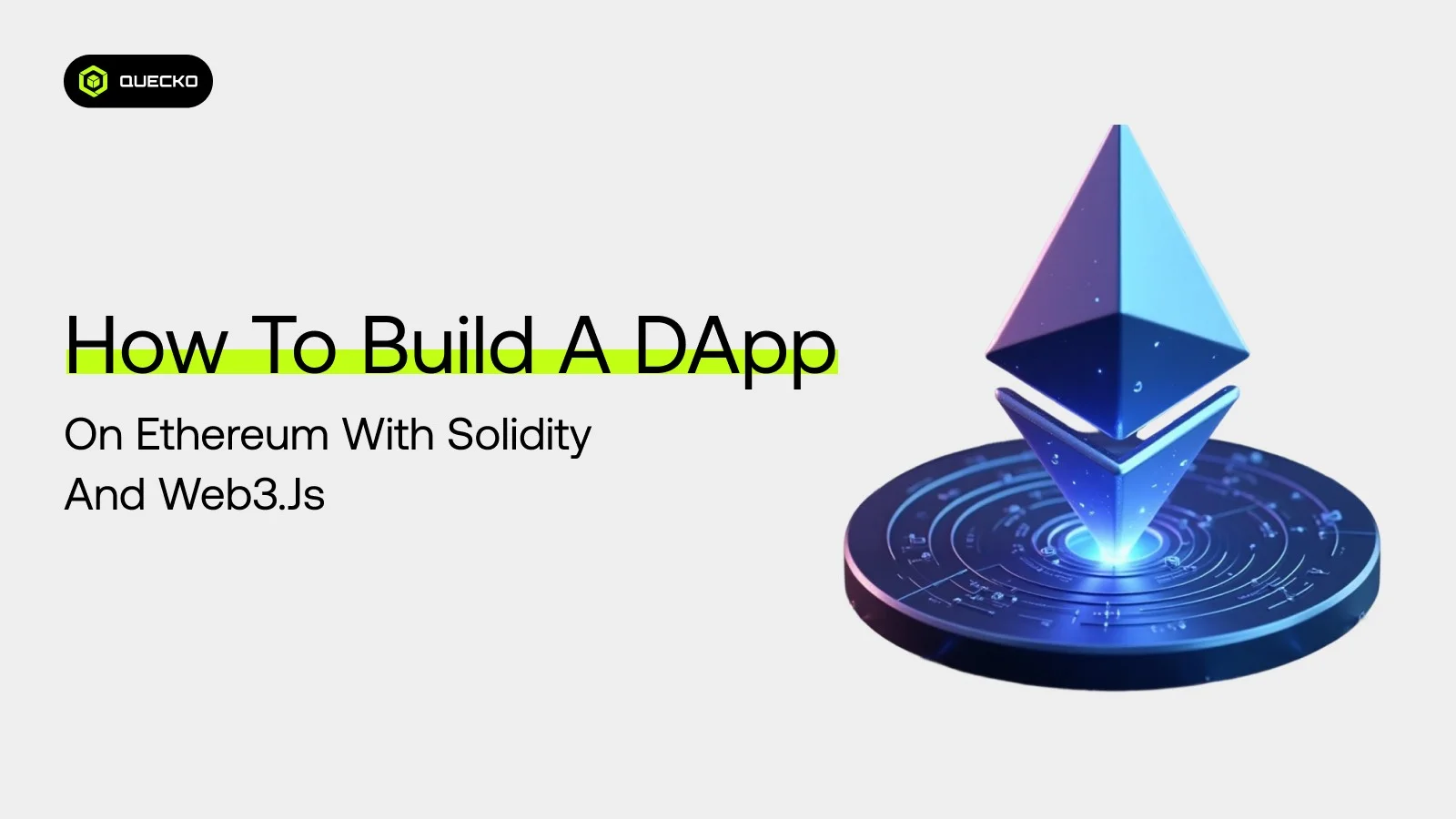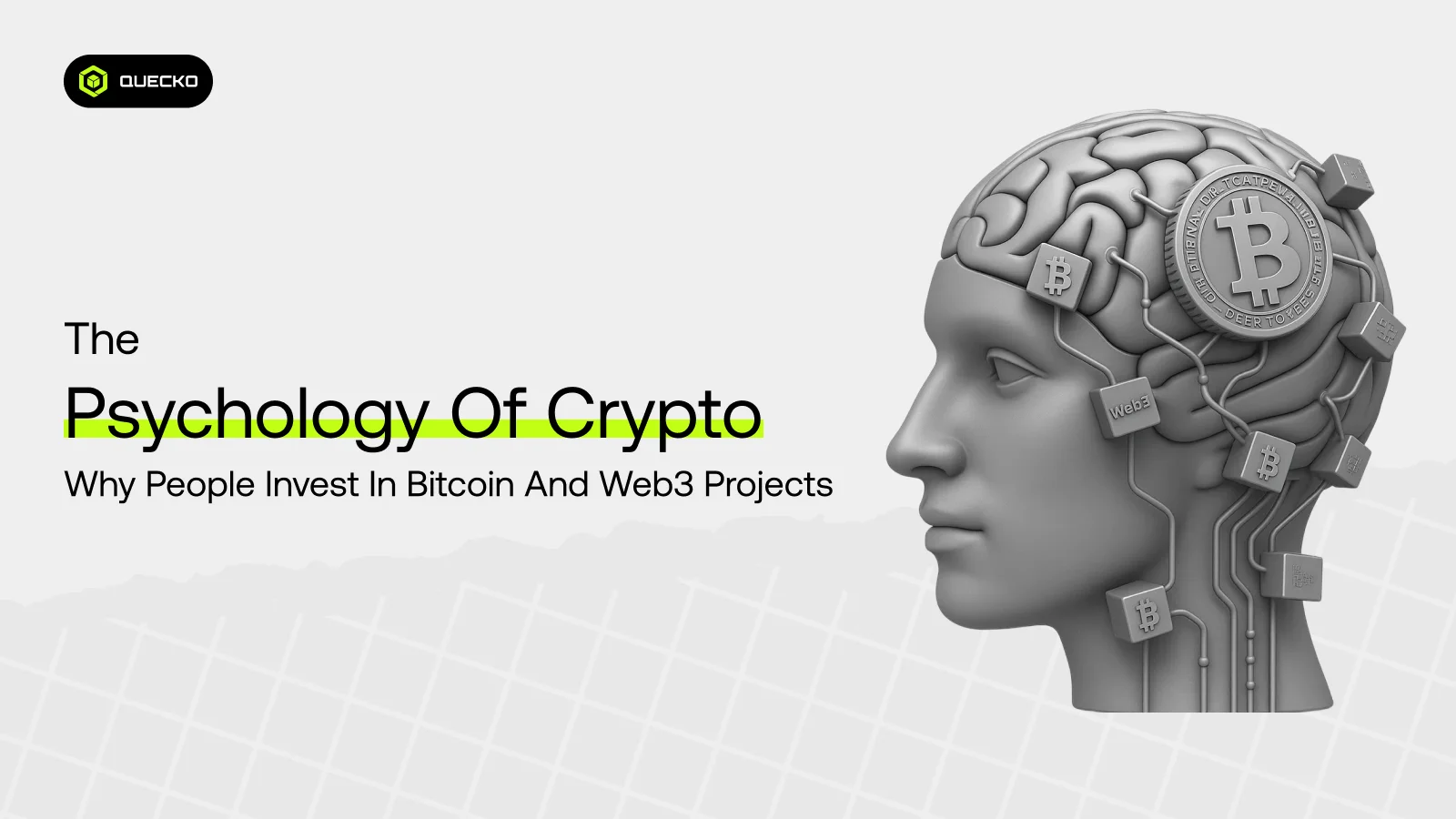How to Build a dApp on Ethereum with Solidity and Web3.js
Learn how to build an Ethereum dApp using Solidity and Web3.js. Explore smart contracts, wallet integration, deployment tools, and key development steps.

The world of decentralized applications (dApps) is growing rapidly because they provide direct control and automation alongside transparency between users without middlemen. The development of dApps now benefits from Web3.js, which connects Ethereum smart contracts under the power of the Ethereum platform.
A detailed explanation is provided, which clarifies the fundamental process along with the required software and comprehension to build an Ethereum-based dApp. When starting with blockchain exploration, either as a developer or entrepreneur, the fundamental knowledge of dApp architecture is the initial requirement. The development process includes various layers that grant users full ownership rights and automation through untrusted execution capabilities.
What Is a Decentralized Application (dApp)?
A blockchain network acts as the operational base of dApps, which function without central server control. The system implements smart contracts, which enable automatic, security-enhanced execution of tasks. Platform development for dApps primarily takes place on Ethereum because of its strong developer resources and active developer network.
DApps demonstrate three key advantages over regular apps by being impossible to censor and providing both transparent operation and open connectivity for users who have internet access. The dependency on third-party intermediaries is eliminated through decentralized protocols, which lead to tamper-proof, trustless user interactions. The digital world experiences transformation through dApps, which bring revolutionary changes to value and data exchange across financial services and the gaming industry, and supply chain management, as well as identity protocols.
Understanding the Building Blocks of a dApp
To build a dApp, you need these key components:
- Smart contracts: The backend logic, written in Solidity, is deployed to the Ethereum blockchain.
- Web3.js / Ethers.js: Connects the frontend to the blockchain
- Wallet (MetaMask): Signs transactions & manages keys
- Decentralized Storage: Stores large data (IPFS, Arweave)
- Frontend interface: A web-based UI that users interact with.
- Blockchain connection: Integration using Web3.js to connect the UI with smart contracts.
Setting Up the Development Environment
A developer requires specific essential tools when creating a dApp on Ethereum because these tools enable streamlined development of smart contracts and blockchain connectivity while managing digital wallets. The tools you need for developing a dApp with Ethereum serve different functions, with alternative options available to match personal preferences or project specifications.
Key Tools
- Hardhat functions as a common environment for developers to create and evaluate, and introduce smart contracts. People can choose Foundry or Truffle as alternative testing frameworks if they want a different configuration than Hardhat.
- Alchemy or Infura provides reliable access to Ethereum nodes, ensuring seamless interaction with the blockchain. Other options include QuickNode for high-performance APIs or Moralis for a more integrated backend solution.
- Metamask stands as the primary dApp integrating wallet, but users can boost wallet accessibility and crypto exchange connectivity through the addition of WalletConnect and Coinbase Wallet.
- Web3.js stands as the top Ethereum library for developer interaction, but developers have the flexibility to choose either Ethers.js or Web3.py based on their programming language selection.
Step-by-Step Setup Guide
Install Node.js and npm: Since most Ethereum development tools are JavaScript-based, ensure you have Node.js (v16+) and npm installed.
Set Up Hardhat: Initialize a new Hardhat project to handle smart contract compilation, testing, and deployment. Hardhat’s plugin ecosystem supports debugging and gas optimization.
Configure MetaMask: Set up MetaMask browser extension with a test wallet, followed by network connection to Sepolia or your own Hardhat Network platform.
Use Alchemy for Node Access: Sign up for an Alchemy account to get an API endpoint, which allows your dApp to interact with the Ethereum blockchain without running a full node.
Step 1: Writing the Smart Contract in Solidity
Start by writing a smart contract that defines the logic of your dApp. This is the core component that handles the business rules, processes transactions, and manages state on the blockchain. People can safely store and retrieve their data through simple storage contracts that require no central server. Advanced decentralized applications contain different functionalities that span from user authentication to asset transfer operations and automated workflow automation. Writing programs with Solidity requires practitioners to maintain code security and efficiency while keeping programs free from errors.
Testing of the smart contract requires thorough examination within the local testing environments, such as the Remix IDE for quick prototyping or Ganache for extensive integration and control testing. Testing early stages permits the detection of both logical mistakes and security issues, which minimizes both time expenses and on-chain deployment costs.
Step 2: Compiling and Testing the Smart Contract
To implement a contract for execution on the Ethereum Virtual Machine (EVM), it requires compilation of its code into bytecode. Remix and Truffle facilitate bytecode compilation for the Ethereum Virtual Machine via interactive feedback that allows developers to detect syntax faults and enhance their code base. The tools enable you to conduct contract interaction simulations, which help identify potential issues before deploying to a live network.
A complete test process at this stage proves imperative because it guarantees that smart contracts operate as intended by identifying various conditions with secure user input processing and handling of edge cases.
Step 3: Deploying the Contract on Ethereum
Blockchain contract development through Truffle and Ganache enables developers to deploy their contracts on a local blockchain network for testing operations and debugging functions. Ganache delivers an Ethereum environment that operates with instant mining and predefined accounts through its service, which enables smooth simulation of real-world blockchain deployments.
After conducting local testing and complete verification of the contract, developers can deploy it to public Ethereum testnets, Goerli, or Sepolia for decentralized testing of its functionality. The testnets exactly match the mainnet structure but operate without actual financial risks. When deploying to the Ethereum mainnet, you will use the production environment that includes assets with actual monetary value. Deployment requires effective management of gas fees in the ETH network because these fees serve to validate and process transactions. The efficiency of code, along with optimized contract designs, enables a substantial reduction of gas expenses.
Step 4: Building the Frontend for Your dApp
Web technologies with traditional frontend frameworks (HTML, CSS, and JavaScript) exist to construct dApp interfaces because they create developer-friendly environments. This interface functions as a connection between blockchain users and dApp features to offer simple access to your application. The blockchain shows users’ output alongside intuitive design elements that let them use friendly components to provide data while activating contract functions.
The frontend interacts with Web3 provider MetaMask, which enables users to link their Ethereum wallet for blockchain operations safely. The user interface serves as an essential component for decentralized systems because each user command, whether to submit forms or request data set, offloads communication with deployed smart contracts.
Step 5: Connecting Smart Contract with Web3.js
Through Web3.js, users can establish smooth communication between blockchain operations and frontend tasks, thus connecting Ethereum blockchain actions to smart contract execution. With Web3.js, your frontend system can obtain blockchain data in real time and perform transaction operations on the blockchain. The user-triggered UI engagements will be processed into requests using Web3.js, which then directs them to the proper smart contract methods. Users need to examine and authorize transactions through their MetaMask wallet before the system executes the transaction for blockchain operations.
Web3.js provides necessary functions for event listening, together with account identification as well as network adjustments, which make it an indispensable tool for creating responsive dApps with complete functionality.
Step 6: Integrating MetaMask and Wallet Authentication
The Ethereum blockchain requires MetaMask as a vital tool to establish wallet connectivity, which enables user engagement. The extension works as a secure interface that stores Ethereum private keys, along with enabling users to handle multiple Ethereum addresses. With MetaMask, users enjoy secure Ethereum blockchain access because they can sign transactions, approve contract calls, and observe their balance through private key encryption.
A proper loading process for your dApp should recognize the presence of MetaMask before asking users to connect their wallet. The application ensures that users’ Ethereum addresses become associated with the dApp for enabling interaction with smart contracts and authorization of transactions. The dApp should provide installation instructions for MetaMask if it cannot detect the wallet, to make sure users can use all available features.
Step 7: Handling Ethereum Transactions and Gas
All transactions related to Ethereum blockchain smart contracts necessitate payment of gas fees for protocol execution. To process transactions, Ethereum needs the payment of gas in ETH, which measures the computational work burden brought by the transactions. A dApp requires attention to gas efficiency during development since gas prices change frequently, which affects the usage of contract computational resources.
Smart contract performance should be optimized, and transaction storage decreased while implementing transaction batched operations for better efficiency. A user must view an estimated gas cost before any confirmation stage through the frontend interface. Users benefit from increased visibility about costs, which enables them to decide wisely while stopping them from encountering hidden expenses. Users of certain dApps can select from different gas limits and priority levels, which give them control over adjusting transaction speed and cost.
Step 8:Using IPFS for Decentralized Storage
Storing large files on Ethereum is expensive, but IPFS (InterPlanetary File System) offers a decentralized alternative. Files uploaded to IPFS receive a unique Content Identifier (CID) that you can store on-chain. Services like Pinata or Infura simplify file management, while public IPFS gateways let users retrieve files using the CID. This approach keeps costs low while maintaining security and accessibility, perfect for NFT metadata, documents, or media files in your dApp. For long-term storage, consider Filecoin or Arweave as additional solutions.
Step 9:Scaling Your dApps
Your dApp requires Layer-2 solutions as an alternative scaling solution to minimize Ethereum transaction fees and improve speed. Optimistic Rollups, including Arbitrum, enable broad-scale scalability through off-chain processing that leads to Ethereum settlement. The high-security applications of zkSync and StarkNet use advanced cryptography to deliver instant transaction finality through ZK-Rollups technology.
Users can perform basic, inexpensive transactions within the independent blockchains of Polygon PoS while such chains remain connected to Ethereum. Various solutions match processing speed with security and cost in a unique way that enables developers to find the most suitable choice for their decentralized application.
Step 10:Monitoring and Analytics
To track your dApp’s performance and user activity, analytics tools provide crucial insights. The Graph indexes and queries blockchain data efficiently, making on-chain information easily accessible. Tenderly helps debug failed transactions by simulating smart contract interactions. For visualizing trends, Dune Analytics creates customizable dashboards using real-time on-chain data. These tools help developers monitor usage, troubleshoot issues, and optimize their dApps effectively.
Benefits of Building on Ethereum
When building on Ethereum, developers gain access to several key advantages that make it an ideal platform for creating decentralized applications (dApps). These benefits include:
Decentralization: No Single Entity Controls the Data
Decentralized control in Ethereum distributes administrative control over multiple nodes, which eliminates dependence on centralized authorities. The decentralized system provides censorship resistance along with reliability and trustlessness, which delivers users complete ownership over their data as well as transactions.
Transparency: All Transactions Are Publicly Recorded
Due to its public and permanent transaction recording system, Ethereum’s blockchain permits full visibility of activities for universal verification. An audit trail of all smart contract functions and payment transactions is possible because Ethereum maintains complete transparency between users.
Security: Data Stored on the Blockchain Is Immutable
Ethereum’s immutable ledger provides tamper-proof security – once recorded, transactions cannot be altered without network consensus. This guarantees data integrity for critical applications like finance, identity systems, and voting.
Automation: Smart Contract Functions Execute Automatically When Conditions Are Met
Ethereum’s smart contracts automate transactions through self-executing code, eliminating intermediaries in applications like DeFi. They trigger actions automatically when conditions are met, enabling trustless lending, trading, and interest payments with minimal human involvement.
Common Use Cases of dApps
Decentralized applications (dApps) are transforming industries by leveraging blockchain technology to deliver secure, transparent solutions. Common use cases include:
DeFi Platforms (e.g., Lending, Trading)
DeFi (Decentralized Finance) platforms give users access to financial activities, including lending, borrowing and trading, and yield farming by eliminating dependence on traditional banks or financial institutions. Smart contracts execute financial operations automatically because they provide total transparency alongside security features that operate independently of third parties. Users can earn interest through cryptocurrency loans on lending platforms. At the same time, decentralized exchange services let users trade funds directly with each other without the need for central oversight and lower overall costs.
NFT Marketplaces
Blockchain-based NFT (Non-Fungible Token) marketplaces provide people with the capability to purchase unique digital assets, which include artworks, musical compositions, and collectibles, while utilizing NFTs as blockchain-based digital representations. Smart contracts verify each NFT, thus securing their authenticity and ownership status. Through OpenSea and Rarible platforms, artists obtain direct economic value from their creations while eliminating traditional distribution channels.
Decentralized Games
Decentralized games execute through blockchain technology to transform virtual gaming items such as characters and skins, and items, into NFTs that belong to players. The play-to-earn system found in these games allows users to earn genuine cryptocurrency along with other tokens. Smart contract coding of game logic creates an automatic system that eliminates centralized control over the game economy while delivering unbiased operations. The gaming world has experienced a revolution through Axie Infinity and Decentraland because these games provide blockchain technology-based real-world asset value to their players.
Voting Systems
Blockchain technology operates decentralized voting systems that deliver a secure system that combines transparency with tamper-proof election and poll management. The blockchain records smart contract votes in an immutable fashion because voters can submit ballots using these contracts, and the blockchain maintains an unalterable permanent record. The utilization of blockchain technology through voting enables both political and corporate entities to conduct secure elections that produce auditable results superior to standard voting practices.
Crowdfunding Platforms
With decentralized crowdfunding platforms, individuals or groups acquire funding through cryptocurrency and token transactions to support different kinds of projects and causes, or startup ventures. The project’s achievement or attaining funding goals through set targets results in automatic money distribution via smart contracts that also enforce established contract terms. These alternative crowdfunding systems need no intermediaries, so they eliminate fees while establishing strong safety measures for project owners and donation givers.
Final Thoughts
The development process of dApps for Ethereum using Solidity and Web3.js appears challenging, but becomes workable when you use proper tools and organizational structures in combination with Blockchain principle comprehension. Blockchain technology enables you to build apps beyond mere app creation, but pushes the blockchain ecosystem forward by giving users enhanced protection and control and better transparency.
Building a dApp requires all elements, such as smart contracts and user interface, to function as separate components that lead to a reliable processing experience. Your ability to master the integrated operations among smart contracts and frontend development, and Ethereum networks becomes crucial for developing any level of DeFi platform. Mastering each component allows developers to reach the maximum capability of dApp development while bringing decentralized solutions to wider audiences.
Date
8 months agoShare on
Related Blogs

The Psychology of Crypto: Why People Invest in Bitcoin and Web3 Projects
11 days ago

Layer 2 Solutions: Scaling Bitcoin and Ethereum Without Breaking the Chain
12 days ago

The Hurdles to a Truly Decentralized Exchange Future
17 days ago

Smart Contracts vs Traditional Contracts: What Businesses Need to Know
1 month ago








